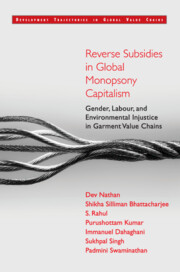 Reverse Subsidies in Global Monopsony Capitalism
Reverse Subsidies in Global Monopsony Capitalism Published online by Cambridge University Press: 21 January 2022
Introduction
In this chapter, we look at the utilization of environmental products and services, or ecosystem services, and the manner in which their costs are met within or externalized from the core garment global value chain (GVC) production system, resulting in subsidies. These ecosystem services include provisioning services, such as raw materials and water, besides other materials used in production, such as fuel, biogenic materials, plant protection, and medicinal materials. The garment GVC also uses regulating services, such as waste decomposition and air and water purification. These provisioning and regulating services are used both in garment production and in the production of raw cotton.
Ecosystem services are either secured through market-based exchanges or extracted by non-market appropriation. Market exchanges include the acquisition of fresh water through payment to local municipalities. This may be underpriced, in the sense that it does not cover the replacement cost of the fresh water. It may also be secured free, as in the extraction of groundwater by raw cotton cultivators. The result of such underpriced or non-priced appropriation is the overuse and depletion of a renewable, but exhaustible, resource.
The cost of ecosystem services also includes the use of water (in the form of a reservoir formed by a dam in the case of garment manufacture in Tiruppur) and land resources (in the case of raw cotton cultivation) for the dumping of waste generated in the production process. Garment factories, particularly through their dyeing and printing segments, produce sludge as waste while raw cotton agriculture produces degraded land with inorganic fertilizer and pesticide residues.
Environmental Subsidies
The manner in which ecosystem service subsidies are created may be partly through the market mechanism and partly through non-market mechanisms. Even in market mechanisms, there may be subsidies through underpricing. Non-market mechanisms of appropriation, as in the case of groundwater for the cultivation of cotton, are a clear case of subsidy. How do we decide that there is underpricing and thus a subsidy? Take the case of water for garment factories. We have to use some system of valuing ecosystem services from renewable natural assets. Non-renewable assets would pose a different problem and we do not go into that. There exist a number of systems for valuing ecosystem services, the most prominent of which are that of contingent valuation and of replacement cost.
To save this book to your Kindle, first ensure [email protected] is added to your Approved Personal Document E-mail List under your Personal Document Settings on the Manage Your Content and Devices page of your Amazon account. Then enter the ‘name’ part of your Kindle email address below. Find out more about saving to your Kindle.
Note you can select to save to either the @free.kindle.com or @kindle.com variations. ‘@free.kindle.com’ emails are free but can only be saved to your device when it is connected to wi-fi. ‘@kindle.com’ emails can be delivered even when you are not connected to wi-fi, but note that service fees apply.
Find out more about the Kindle Personal Document Service.
To save content items to your account, please confirm that you agree to abide by our usage policies. If this is the first time you use this feature, you will be asked to authorise Cambridge Core to connect with your account. Find out more about saving content to Dropbox.
To save content items to your account, please confirm that you agree to abide by our usage policies. If this is the first time you use this feature, you will be asked to authorise Cambridge Core to connect with your account. Find out more about saving content to Google Drive.